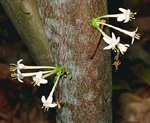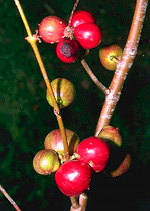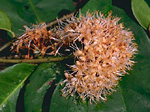 |
This is a widespread tropical and temperate family of moderate size, most diverse in Australia and tropical Africa. Most members in Australia are shrubs found in temperate, open forests and shrublands. Some occur in open communities in the tropics, especially close to beaches and headlands, while a few are rain forest trees.
Characteristic features of the family Thymelaeaceae in Australia include: - shrubs or small trees, often with distinctively strong, smooth bark that is difficult to break when stripped from the stems
- usually pale-coloured, tubular flowers, usually with a prominent, free hypanthium
- petals are often inconspicuous or lacking, or replaced by scale-like structures at the summit of the hypanthium
- stamens vary in number, but almost always 2 in the largest genus (Pimelea)
- ovary free and superior within the hypanthium, with 1 apical ovule in each locule
Description
Evergreen trees or shrubs, or annual or perennial terrestrial herbs. Perennating
by tubers or stolons. Vegetative reproduction absent, or by tubers or
stolons. Stems unarmed, or rarely with thorns or spines arising from the
leaf axils. Internal secretions not obvious. Plants glabrous, or with
simple, non-glandular, unicellular hairs. Leaves alternate and spiral,
or distichous, or opposite, cauline if herbs, petiolate, subsessile or
rarely sessile. Stipules absent, or present and distinct and free from
the petiole, bristle-like. Lamina simple, symmetric, filiform, acicular,
subulate, linear, lanceolate, ovate, elliptic, oblanceolate, oblong or
orbicular; base cuneate, attenuate or rounded; margins entire, ±flat,
revolute, recurved, involute or incurved; one-veined, or the venation
pinnate, with the midrib conspicuous or inconspicuous, and the tertiary
venation not reticulate; surfaces not punctate; herbaceous or leathery.
Male and female flowers occurring on separate plants or rarely occurring
on the same plant, or with all the flowers bisexual. Inflorescences terminal,
axillary, or apparently cauliflorous or ramiflorous, consisting of racemes
or umbels, or apparently capitula or spikes. Bracts and bracteoles present
or absent. Pollination by insects or rarely birds. Flowers odourless or
fragrant, stalked or subsessile. Floral disc present or absent; nectaries
absent or present on the disc. Free hypanthium present, often coralloid
and coloured, or absent. Perianth usually of 1 whorl only, or rarely of
2 dissimilar whorls. Calyx regular, sepaloid or petaloid; segments free
or fused, of 46 sepals or lobes, valvate or imbricate in bud; calyx urn-shaped,
funnel-shaped, wheel-shaped, salver-shaped or tubular, white, cream, yellow
or greenish, without contrasting markings. Corolla usually absent, or
regular if present, often scale- or gland-like and inserted in the throat
of the hypanthium; segments free, with 46 or 812 petals, alternating
with or both opposite to and alternating with the sepals or calyx lobes,
valvate in bud, white or cream, without contrasting markings, membranous;
claws absent; lobes ±entire. Fertile stamens 12, 4, or 8numerous,
not clearly correlated with or rarely opposite to the sepals or calyx
lobes, free or at least partly fused to the corolla, free of the ovary
and style, distinct from each other or fused by their filaments into an
open or closed tube, all ±equal or distinctly alternating long
and short. Staminal filaments present or rarely apparently absent. Anthers
dorsifixed or basifixed, ?versatile or not versatile, opening sideways
or inwards by longitudinal slits, 2-celled. Ovary superior and sessile.
Carpels 212, fused; ovary with 12 or 512 locules. Style terminal or
eccentric, single and unbranched, or absent and the stigma ±sessile
(rarely, by misinterpretation). Ovules 1 per locule; placentation apical.
Fruit dry or fleshy, dehiscent or indehiscent; a loculicidal capsule,
or a nut ±immersed in the expanded hypanthium (diclesium), or a
drupe; the perianth on the maturing fruit deciduous or dry and persistent.
Disseminule macro-surface featureless or with straight hairs; micro-surface
±smooth, orange, red, green, brown or grey, glossy or dull. Seeds
110 per fruit. Aril ?present or absent. Cotyledons 2. Embryo straight.
(Note: this description has been generated from the coded data compiled for the key. Any errors in the key data will be reflected in the descriptions.)
A treatment of the family Thymelaeaceae has been published in:
Flora of Australia 18: 122-215.
Australian genera of Thymelaeaceae (as recognised for the Flora of Australia)
* = all species introduced
Arnhemia
Drapetes
Jedda
Kelleria
Lethedon
Oreodendron
Phaleria
Pimelea
Thecanthes
*Thymelaea
Wikstroemia

|
  |

Lethodon setosa (fruits)
Photo: H.Nicholson © H. & N. Nicholson

Phaleria clerodendron (flowers)
Photo: M.Fagg © M.Fagg

Phaleria clerodendron (fruits)
Photo: D.Jones © D.Jones

Phaleria octandra (flowers)
Photo: D.Jones © D.Jones

|
 |
|